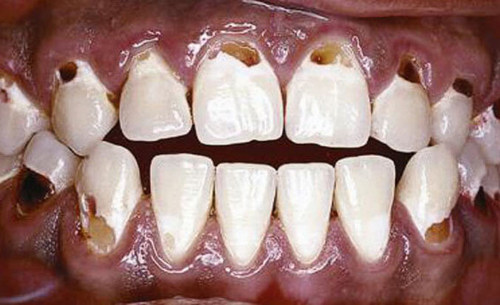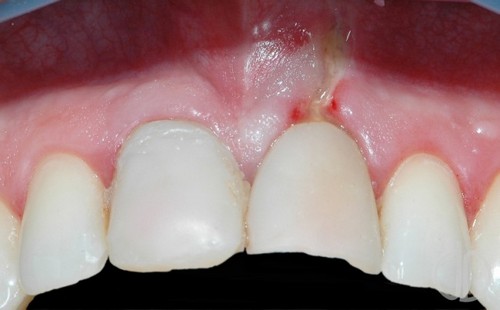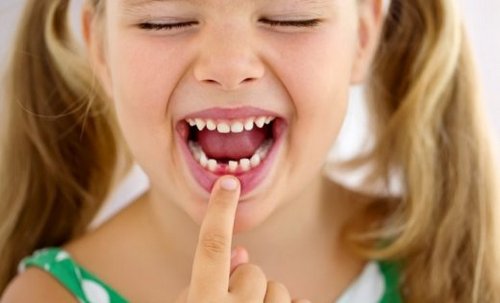Generally, early lose of primary teeth by caries is associated with lesions of the dental germs in utero. The formation of the dental germs in the embryo begins in the first trimester of pregnancy. That is why the diseases of the future mother, moved in this period, or medications may cause violation of proper development of teeth in the fetus.
The causes of tooth decay
The basis of problems with their teeth after their eruption lies bad oral hygiene and improper eating habits. The latter, first of all, you need to include prolonged use of a nipple.
Children, who for too long can’t go from bottle to drinking from a Cup or sippy cups, especially the kids that every night I fall asleep with a bottle in his mouth, took the biggest risk of the development of the so-called bottle caries.
In this type of the disease from prolonged contact of liquid from a bottle (generally if she’s sweet) teeth affected by caries all his front teeth, and the process extends around the circumference of the coronal portion of the tooth, i.e. around the whole of the visible part of the tooth on the perimeter.
And of course, a child up to 3 years of age should not snack between meals, especially foods containing large amounts of carbohydrates (chocolate, candies, etc.). As sweets it is better to offer fruit, biscuits, dried, pastries, marmalade, candy.
Sweet to eat after Breakfast or after dinner, and after that in a short time to brush my teeth. Indeed, virtually no child can grow without sweets, only their use must be reasonable and limited.
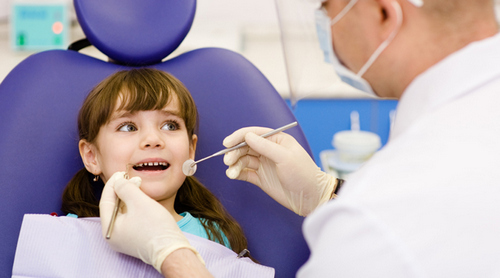
Forbidden fruit is sweet…
- Not to seduce a child view of “forbidden fruit”, you just need not to buy them and not have themselves. Grandmother, other relatives and friends of your family, of course, bring candy for the kid with the best of intentions. But in your power to talk to them and explain what you can bring to a child instead of candy book, pictures, toys, etc.
- Poor oral hygiene (or lack thereof) leads to the fact that the plaque remaining on teeth after a meal, turns into the so-called dental plaque, which contains bacteria that produce lactic acid, in turn, may cause damage to the enamel and affect the development of caries.
- With the emergence of the first teeth in a child should receive a toothbrush and toothpaste suitable for his age. Early to develop the habit of brushing teeth 2 times a day (morning and evening after meals) will help to avoid many problems.
Signs of tooth decay in children
The depth of the lesion, the caries of deciduous teeth are divided into several types.
- Starting on the enamel appear white spots of various shapes and sizes, there is no pain. If left untreated, the process progresses the spots become dark brown, and black. With timely treatment the progression of the caries can be paused.
- Surface – tissue defect of the tooth within enamel. A cavity can be light or dark. The pain appears when exposed to sweet, sour, salty. Need filling the cavity.
- Medium – affects the tooth enamel and part of dentin (the tissue inside the tooth). Pain can arise from sweet, salty, cold and hot. Need filling the cavity.
- Deep – struck enamel and a large portion of the dentin. The method of treatment depends on the condition of the pulp (the soft tissue of the teeth): fillings or conservative treatment use of medicinal pads in combination with delayed filling.
For children characterized by multiple lesions of teeth (affected may be all the 20 milk teeth). In addition to childhood is characterized by the occurrence of several carious cavities in one tooth. Also some children due to anatomical and physiological features of the structure of their teeth the layer of enamel and dentin is thinner, solid fabrics have high permeability, and all this leads to the rapid spread of the carious process at the tooth surface, but also deep. As a result, the process extends to the deeper tissues, and develop pulpitis and periodontitis.
Pulpitis is a disease in which soft tissues of the tooth (pulp) would be covered by the inflammatory process. The clinical picture of pulpitis may develop within a few hours. Usually before that child makes minor complaints, then there is a sharp pain mostly at night or pain from thermal stimuli. Such complaints suggests that, most likely, a cavity is so deep that penetrated to the pulp of the tooth. Requires immediate intervention by the physician.
If the tooth was ill many times, there is swelling of the cheeks or gums, the mucosa near the tooth has a fistula (hole) with purulent discharge, there is pain when biting on the tooth, it means that the pathological process has spread beyond the tooth and there was a pyorrhea – inflammation of tissues surrounding the tooth. The doctor will choose the right tactics in the treatment of periodontitis individually, but most likely, such a tooth can not be cured and must be removed.
Beware
- If the child’s teeth formed plaque that you cannot remove by yourself, white or, on the contrary, brown spots, it means that there is an urgent need to show the baby a pediatric dentist.
- A child’s complaints of discomfort during eating, from cold and hot food say that tooth decay has moved into the deeper layers of the tooth. Such complaints should alert the parents and cannot be ignored.
- Sometimes a small child can’t articulate what’s bothering him, so the rejection of food or any particular kind of food, chewing on one side, etc. also can be a sign of pain in the teeth.
Methods of treatment of caries in children
At the initial stage of caries development in children can be used a method of silver plating enamel, in which untreated carious cavity is applied a special solution containing silver ions. As a rule, it is a temporary measure in the fight against tooth decay. In addition, during the application of preparations of silver there is a strong staining of tooth in black, which looks not aesthetically pleasing enough.
The most traditional methods of treatment of caries of deciduous teeth includes the removal of diseased tooth tissue with a dental drill under local anesthesia or without it. The decision on necessity of application of local anesthesia the doctor takes each case individually.
Sometimes no amount of persuasion did not help, and the child does not hear the arguments of the physician and parents about the need for “open mouth” or “to show, to treat teeth.” Typically, this problem is typical for children of 3 years or for children suffering from concomitant diseases. Then there is the question of dental treatment under General anesthesia.
It is always important to remember that treatment under General anesthesia is only one of the options offered by modern dentistry. This method should be applied strictly according to indications and can not be widespread.
The child should not be afraid of the dentist, it is advisable to befriend him, to feel the need for dental treatment. Because he will have to face this problem throughout their life. Much of the psychological mood depends on the parents and relatives of the baby, which sometimes send him your fear of dentists. Try to explain to the child the need to visit a dental doctor and set it up not to be afraid of this procedure.
Prevention of dental caries
Caries can occur in children from a very early age, so preventive measures should be with the appearance of the first tooth.
Prevent cavities you can, removing from the mouth, food debris and microbial plaque with hygiene of the oral cavity. First of all, these include a toothbrush and toothpaste.
A possible alternative
Than brushing teeth.
The opinions of experts about when to start brushing your teeth with the paste diverge. The taste of pasta may seem the child unpleasant, so the use of toothpaste is better to start after the first year of life. Toothpaste in its composition must be appropriate to the age of the child – this information is on the packaging.
A child up to 3 years, the toothpaste should not contain fluoride. At this age, children swallow a large part of the paste and do not know how to rinse your mouth. Fluorine is the active element, and swallowing large amounts of toothpaste that contains fluoride, can cause serious consequences and requires immediate treatment to the doctor.
From 4 years children are able to partially spit out the remains of the paste after brushing. That is why toothpastes for this age contain fluoride. The maturation process of the enamel of the teeth is accelerated by regular use of hygiene products containing the active fluorine, with proven significantly reduced risk of dental caries.
Toothbrushes for children are extremely diverse. For the first teeth fit brush-fingertips, which the mother can easily and gently remove plaque from the teeth of the baby.
To 2.5-3 years should be gradually teach your baby to self-cleaning teeth, giving him the handle of the toothbrush.
How to brush your teeth?
Sometimes trying to clean the teeth may cause a negative reaction. Do not be upset because of this. You need to have patience and… play. Child up to 3 years, and later, learns about the world through play. So you should not insist on brushing your teeth, hoping that he understands how important this is. You just need to play. For this game, good and brush on batteries with a toy on the handle.
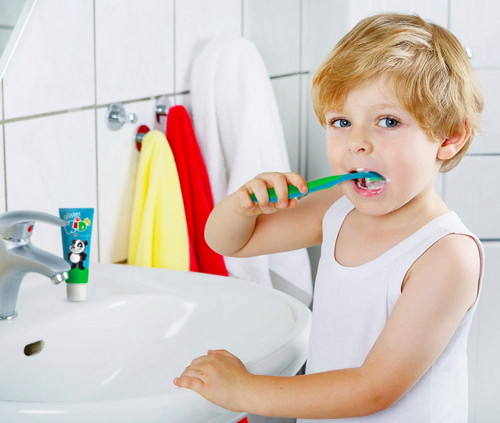
A movement committed toothbrush needs to be different for different groups of teeth.
Front teeth clean vertical unidirectional motions, from the gums. For cheeks – in a circular motion with the serried teeth. The chewing surface of teeth brush horizontal movements back and forth, from the inside (by the tongue and palate) sweeping movements upstairs, as “whisk”.
It is important not only what the movement accomplished, but how much of this dedicated time.
To monitor adequacy of cleaning teeth, there are two ways:
- the first – time (about 10 minutes to clean all the teeth), which can use sand or any other clocks;
- second – the number of movements (5-6 movements for each site occupied by a bristle brush).
Proper nutrition
Prevention of dental disease includes a balanced diet, that is nutrition, in which food contains proteins, fats, carbohydrates, vitamins, mineral substances necessary for proper growth and formation of tissues of the teeth.
For infants is of course breast feeding. For older children – the introduction in the diet of all the necessary types of foods recommended for this age.
Additional sources of fluorine can be the fluoride salt and water, their application does not require any special readings.
The main sources of calcium are: dairy products, cheese, curd, potato, gooseberry, buckwheat, oats, Roch, some types of mineral water.
First visit to a dentist
The need in the first visit of the child to the dentist usually occurs two reasons: preventive examination for admission in preschool or in case of any complaints. In any case, the first visit to the dentist should not be delayed if the child is older than 4 years.
To visit a dentist is required 2 times a year. If the carious process has already begun, for such period he will not have time to spread deep, the tooth will be saved and will not have caries complications (pulpitis, periodontitis).
In addition, the sooner a dentist finds tooth decay, the less painful and more successful the treatment will be, and in some cases, at initial stages of surface caries will be possible to manage without instrumental intervention, after a treatment with mineralizing funds, causing the therapeutic solutions of fluoride and calcium to the damaged areas of the enamel.
Dentist provides not only dental treatment, but also preventive measures aimed at keeping teeth and gums healthy:
- carries out professional oral hygiene (removes plaque);
- handles the teeth with preparations of fluorine and calcium;
- little teaches the patient proper cleaning of the teeth;
- if necessary, appoints a General treatment (vitamin and mineral additives);
- together with parents, corrects the mode and composition of the diet of the child, identifies harmful habits;
- conducts sealing of fissures (grooves on the chewing surface of the tooth). This preventative measure is aimed at preventing caries in permanent teeth.

